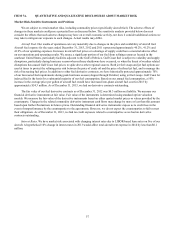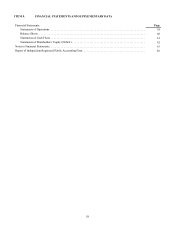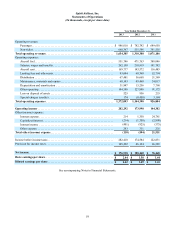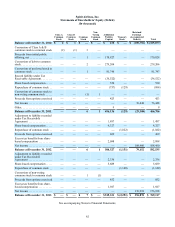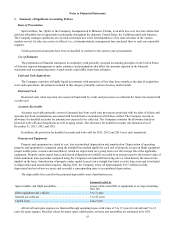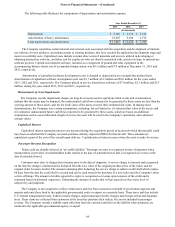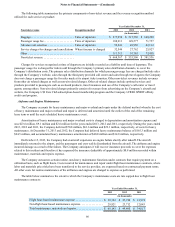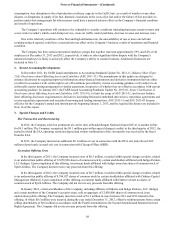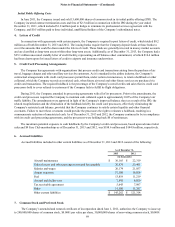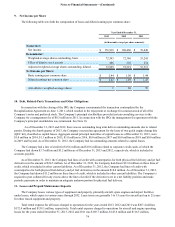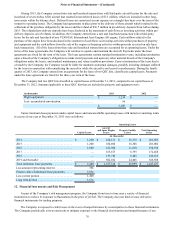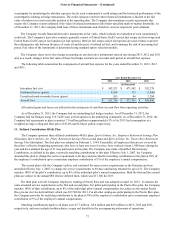Spirit Airlines 2013 Annual Report Download - page 67
Download and view the complete annual report
Please find page 67 of the 2013 Spirit Airlines annual report below. You can navigate through the pages in the report by either clicking on the pages listed below, or by using the keyword search tool below to find specific information within the annual report.Notes to Financial Statements—(Continued)
67
Leased Aircraft Return Costs
Costs associated with returning leased aircraft are accrued when it is probable that a cash payment will be made and that
amount is reasonably estimable. Leased aircraft return costs are recorded as a component of aircraft rent and characterized as
supplemental rent. Any accrual is based on time remaining on the lease, planned aircraft usages and the provisions included in
the lease agreement, although the actual amount due to any lessor upon return will not be known with certainty until lease
termination.
Aircraft Fuel
Aircraft fuel expense includes jet fuel and associated “into-plane” costs, taxes, oil and all gains and losses associated with
fuel hedge contracts.
Derivative Instruments
The Company accounts for derivative financial instruments at fair value and recognizes them in the balance sheet in
prepaid expenses and other current assets or other current liabilities. For derivatives designated as cash flow hedges, changes in
fair value of the derivative are generally reported in other comprehensive income and are subsequently reclassified into
earnings when the hedged item affects earnings. For the years ended 2013, 2012 and 2011, the Company did not hold derivative
instruments that qualified as cash flow hedges for accounting purposes. As a result, changes in the fair value of such derivative
contracts were recorded within aircraft fuel expense in the accompanying statements of operations. These amounts include both
realized gains and losses and mark-to-market adjustments of the fair value of unsettled derivative instruments at the end of each
period.
Advertising
The Company expenses advertising and the production costs of advertising as incurred. Marketing and advertising
expenses were $2.1 million, $2.4 million and $2.5 million for the years ended 2013, 2012 and 2011, respectively.
Income Taxes
The Company accounts for income taxes using the liability method. The Company records a valuation allowance to
reduce the deferred tax assets reported if, based on the weight of the evidence, it is more likely than not that some portion or all
of the deferred tax assets will be not realized.
Interest Expense
Related-party interest expense incurred during 2013, 2012 and 2011 was $0.0 million, $0.0 million and $21.0 million,
respectively, and consisted primarily of paid-in-kind interest on tranche notes due to related parties, and preferred stock
dividends due to related parties. Non-related party interest expense during 2013, 2012 and 2011 was $0.2 million, $1.4 million
and $3.8 million, respectively.
Stock-Based Compensation
The Company recognizes cost of employee services received in exchange for awards of equity instruments based on the
fair value of each instrument at the date of grant. Compensation expense is recognized on a straight-line basis over the period
during which an employee is required to provide service in exchange for an award. The Company has issued and outstanding
restricted stock awards, stock option awards and performance share awards. Restricted stock awards are valued at the fair value
of the shares on the date of grant. To the extent a market price was not available, the fair value of stock awards was estimated
using a discounted cash flow analysis based on management’s estimates of revenue, driven by assumed market growth rates
and estimated costs as well as appropriate discount rates. These estimates are consistent with the plans and estimates that
management uses to manage the Company’s business. The fair value of share option awards is estimated on the date of grant
using the Black-Scholes valuation model. The fair value of performance share awards is estimated through the use of a Monte
Carlo simulation model. See Note 8 for additional information.
Concentrations of Risk
The Company’s business has been, and may continue to be, adversely affected by increases in the price of aircraft fuel,
the volatility of the price of aircraft fuel, or both. Aircraft fuel was the Company’s single largest expenditure representing
approximately 40%, 41% and 42% of total operating expenses in 2013, 2012 and 2011, respectively.
The Company’s operations are largely concentrated in the southeast United States with Fort Lauderdale being the highest
volume fueling point in the system. Gulf Coast Jet indexed fuel is the basis for a substantial majority of the Company’s fuel


